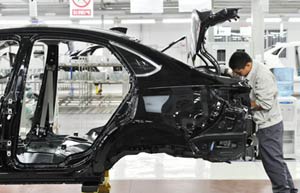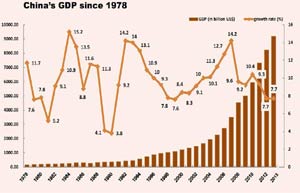BEIJING - A raft of weaker-than-expected economic indicators released Thursday highlighted downward pressures for China's economy and prompted analysts to eye further easing policies in the near term.
The National Bureau of Statistics (NBS) said in a statement that China's industrial output grew 7.7 percent year on year in October, down from an 8-percent increase in September.
The October pace was 0.3 percentage points lower than the market consensus projection, marking the second lowest monthly reading since April 2009 after August 2014.
For the first 10 months, industrial-production growth decelerated to 8.4 percent year on year, down 0.1 percentage points from the first nine months of 2014, the NBS said.
China uses industrial production, officially called industrial value added, to measure business activities of designated large enterprises that have annual turnover of at least 20 million yuan ($3.25 million).
Industrial production accounted for 44.2 percent of China's total GDP in the first nine months of 2014, making it one of the best leading indicators for China's GDP growth.
NBS's new data also shows that fixed asset investment continued to dip in the first 10 months, affected by a cooling property sector and weak domestic demand, and retail sales growth retreated for a fifth-straight month in October.
Analyst at the China International Capital Corp (CICC), Bob Liu, said the weaker-than-expected data served as evidence that downward pressures on growth still existed.
Industrial output is likely to slow further in November because of restrictions placed on factories and construction in Beijing and neighboring regions to keep the air clean during the Asia-Pacific Economic Cooperation (APEC) meetings, which ended on Nov 11.
"Industrial production growth moderated, as the one-off boost from faster electronic output faded. Otherwise, the downward pressures on the industrial sector persisted," according to a note from HSBC's research team headed by Qu Hongbin, the institution's chief China economist.
Production of the telecommunication and computer sector registered a sharp acceleration of 16.6 percent in September, but slowed to 12.2 percent in October.
However, analysts also see some positive signs in the latest figures.
"The slowdown in headline fixed asset investment actually masked a rebound in single monthly investment growth from an all-time low," according to the HSBC.
Infrastructure investment growth accelerated in the first 10 months and the property sector also showed some signs of life, as the contraction in sales eased, and investment growth rebounded.
Since mid-October, the National Development and Reform Commission, China's top economic planner, has accelerated project approvals, including some railway and airport projects.
"In our view, this will help cushion the slowdown in property and manufacturing investment in the fourth quarter and prevent a collapse in investment into 2015," Chang Jian, Barclays chief China economist, said in a note.
Thus, Barclays lowered its full-year growth forecast for 2014 to 7.3 percent from 7.4 percent, but maintained a 7-percent forecast for 2015, Chang said.
China's GDP expanded at 7.3 percent in the third quarter of this year, down from 7.4 for the first half but still remained within the "reasonable range" set by policymakers.
"We maintain our call for two cuts in the benchmark interest rates, one in the fourth quarter and one in the first quarter of 2015," Chang said.
HSBC said it continued to expect more monetary and fiscal easing in the coming months.
Japan-based Nomura Securities also said in a note that it expected 50 basis points of reserve requirement ratio cuts this quarter and in each subsequent quarter through the fourth quarter of 2015.
 |
 |
| Curbs may hit industrial output | Infographics: China's GDP growth since 1978 |
